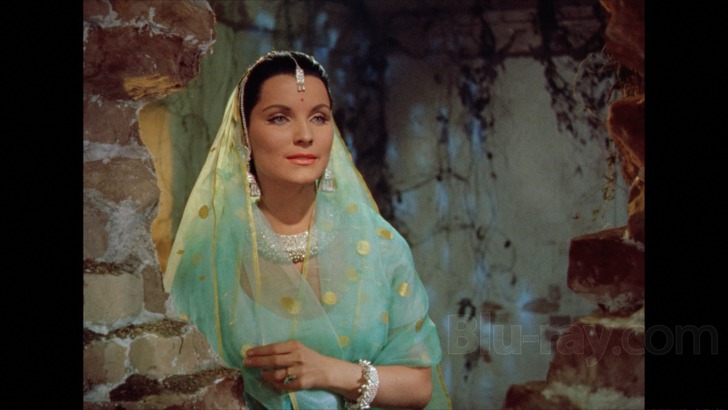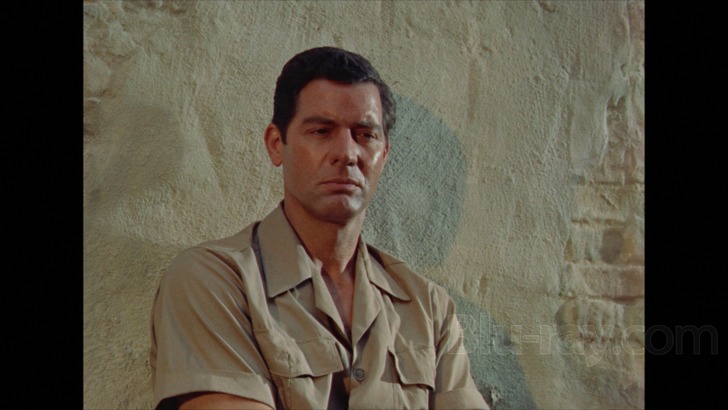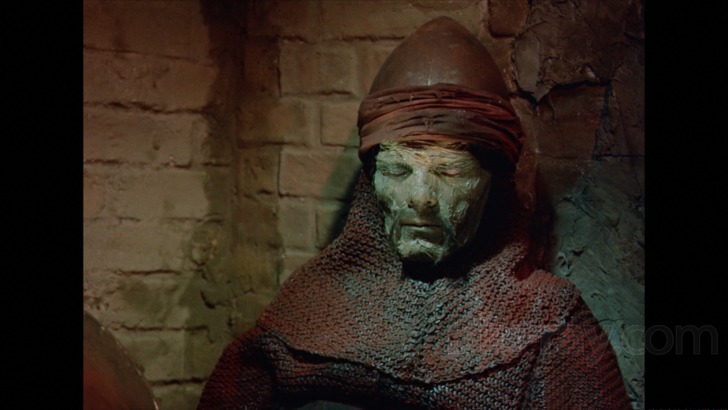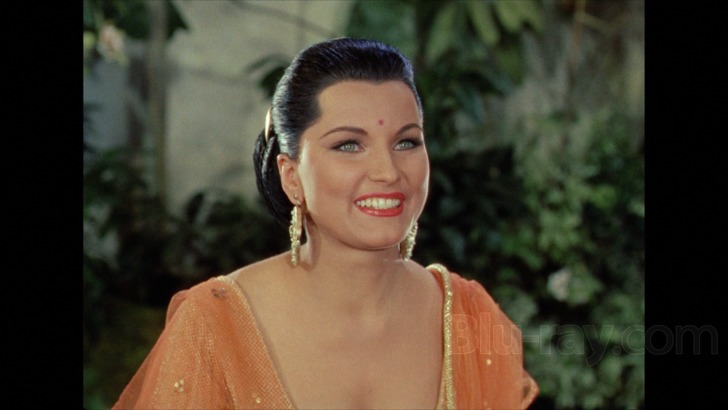The Tiger of Eschnapur Blu-ray Movie
HomeThe Tiger of Eschnapur Blu-ray Movie 
Der Tiger von EschnapurFilm Movement | 1959 | 101 min | Not rated | Early 2020

Price
Movie rating
6.8 | / 10 |
Blu-ray rating
| Users | 0.0 | |
| Reviewer | 3.0 | |
| Overall | 3.0 |
Overview
The Tiger of Eschnapur (1959)
Architect Harold Berger (Paul Hubschmid) arrives in India to meet with Maharahaja Chandra (Walter Reyer), for whom he will build a temple. En route to the Maharahaja's palace, Berger meets a dancer named Seetha (Debra Paget) and saves her from a tiger. Seetha is promised to the Maharahaja, but...
Starring: Debra Paget, Paul Hubschmid, Walter Reyer, Luciana Paluzzi, Claus HolmDirector: Fritz Lang
| Foreign | Uncertain |
| Drama | Uncertain |
| Romance | Uncertain |
| Adventure | Uncertain |
| Thriller | Uncertain |
Specifications
Video
Video codec: MPEG-4 AVC
Video resolution: 1080p
Aspect ratio: 1.37:1
Original aspect ratio: 1.37:1
Audio
German: LPCM 2.0 Mono
Subtitles
English
Discs
Blu-ray Disc
Single disc (1 BD)
Playback
Region A (B, C untested)
Review
Rating summary
| Movie | 3.0 | |
| Video | 4.0 | |
| Audio | 3.0 | |
| Extras | 2.0 | |
| Overall | 3.0 |
The Tiger of Eschnapur Blu-ray Movie Review
Reviewed by Jeffrey Kauffman February 13, 2020 Note: This film is available as part of Fritz
Lang's Indian Epic.
Orientalism has become an increasingly disparaged term, not the least due to Edward Said’s late seventies opus bearing that name which
made
the perhaps obvious point that many artists who engage in so-called “ faux Eastern” approaches tend to be looking down on their subject.
It
wasn’t always so, of course, and Orientalism in music especially has tended toward loving homages, introducing orchestral colors, scales and
harmonies which serve as the classical counterpart to the “exotica” craze of the late fifties in more popular music. But as commentator David Kalat
freely “confesses” early in his commentaries on these releases, the “Orientalism” on display in Fritz Lang’s Indian Epic may strike some as
decidedly more problematic. As Kalat gets into, not only is there the sight of caucasian actors portraying Indian folks, they often are adorned with
the
ironically termed “Egyptian” makeup that browns their skin. The whole depiction of Indian culture in both of the films comprising the Indian
Epic
is often whimsical at best, and downright historically inaccurate at worst. And while there’s a kinda sorta “fairy tale” ambience to much of the
story, that still can’t probably completely excuse some of the ethnically charged subtext of the film, which includes some interesting if largely
unexplored hints that a temple dancer named Seetha (Debra Paget, here dubbed into German by a very smoky voiced actress) may be a
so-
called “half breed”, with only one Indian parent.

As odd as it may sound, another film which used copious amounts of “Egyptian” makeup (perhaps more appropriately, given its setting), 1955’s Land of the Pharaohs, bears some curious resemblances to The Tiger of Eschnapur. Both films document what amounts to a nascent ménage à trois involving a curvaceous woman and two men, one an architect and the other a member of royalty. In this case, the curvaceous woman is the aforementioned Seetha (Debra Paget), the architect is a German named Harold Berger (Paul Hubschmid), and the royal personage is Maharaja Chandra (Walter Reyer). Also, as with Land of the Pharoahs, plotting is rather slow, with production design and cinematography often being more immediately captivating than the actual story.
As David Kalat kind of cheekily jokes, the choice Seetha faces comes down to whom she prefers: a guy who saved her from a marauding tiger (Harold), or someone who offers her priceless gems (the Maharaja). There isn’t really much else to the plot, despite a prevalence of cult like religious members and a frankly erotic “ritual” dance by Seetha (one that is topped by another dance in this film’s follow up). The film does kind of hilariously build to a "cliffhanger" of sorts (perhaps more appropriately, a dune hanger), as Harold and Seetha find themselves exiled after the Maharaja thinks they're involved.
The Tiger of Eschnapur Blu-ray Movie, Video Quality 

The Tiger of Eschnapur is presented on Blu-ray courtesy of Film Movement Classics, an imprint of Film Movement, with an AVC encoded 1080p transfer in 1.37:1. The insert booklet states this is a new 4K restoration, but no further information is provided. From a palette standpoint, this is a stunner every step of the way, with both bold primaries and some very appealing almost pastel hues really popping with some considerable authority. Detail levels are generally good as well, though the entire transfer is a bit on the soft side. There's a curious moment just a bit past the 37 minute mark where the image takes a sudden and pretty drastic downturn (compare screenshots 8 and 9, with 9 being the obviously worse looking moment). I didn't hear Kalat mention this in his commentary, but I'm wondering if this snippet (which is part of Seetha's provocative dance) was excised at some point and needed to be reinserted from a secondary (or even tertiary) source. Other than that pretty gritty and distressed moment, there's no other significant damage to report. Grain resolves naturally throughout the rest of the presentation.
The Tiger of Eschnapur Blu-ray Movie, Audio Quality 

The Tiger of Eschnapur features an LPCM 2.0 mono track in the original German. As mentioned above, Paget is dubbed, as I assume some of
the other actors may have been as well. That said, dialogue is rendered cleanly and clearly throughout this track. There is some noticeable distortion
in some of the music cues, notably the opening credits music, which kind of cracks and breaks up in the higher registers. There's a bit of background
hiss and occasional pops and cracks, but not at the level heard in The Indian Tomb. I'm scoring this at 3.0 to temper expectations, but when
compared to The Indian Tomb, this probably deserves a 3.25.
Note: There evidently was an English language version of this released (it's pretty obvious that Paget is speaking English at least some of the
time, based on her lip movements), but unfortunately that version is not offered here.
The Tiger of Eschnapur Blu-ray Movie, Special Features and Extras 

- Audio Commentary by Film Historian David Kalat
- The Indian Epic Documentary (480i; 21:03) seems to have perhaps been a television outing devoted to Lang and this set of films. In German with English subtitles.
- The Tiger of Echnapur Trailer (1080p; 1:03)
The Tiger of Eschnapur Blu-ray Movie, Overall Score and Recommendation 

Kalat's very appealing commentary gets into some of the convoluted history of this project, which actually has a personal connection to Lang (his ex- wife Thea von Harbou wrote the source novel and was involved in the first film adaptation from the 1920s, an adaptation Lang himself wanted to make but which was wrested from him, leading to his migration to Ufa). Lang may have thought he was finally going to be able to achieve a long held dream with this diptych, but his reach may have at least slightly exceeded his grasp, as this first film is a pretty fitful enterprise, albeit one that is always colorful, if also occasionally outright laughable (as even Kalat admits) in terms of some of its "special effects" involving the tiger. Paget is certainly an eyeful here, and her dancing is a highlight of the film. Technical merits range from generally excellent (video) to passable (audio), and the supplements are quite interesting, for those who are considering a purchase.
Similar titles
Similar titles you might also like
(Still not reliable for this title)

The Indian Tomb
Das indische Grabmal
1959

The Holy Mountain
Der heilige Berg
1926

Omar
2013

Pandora's Box
Die Büchse der Pandora
1929

Birds of Passage
Pájaros de verano
2018

Aquarius
2016

The Sheik
Paramount Presents #25
1921

The Lunchbox
Dabba
2013

L' Argent
1928

Le Notti Bianche
White Nights
1957

...And God Created Woman
Et Dieu... créa la femme
1956

Mauvais Sang
The Night is Young | Special Edition including Mr. X
1986

Les Dames du Bois de Boulogne
1945

Saraband
2003

Boy Meets Girl
1984

Beau Travail
1999

Claire's Knee
Le genou de Claire
1970

Charulata
চারুলতা / The Lonely Wife
1964

Le Amiche
1955

The Music Room
জলসাঘর / Jalsaghar
1958